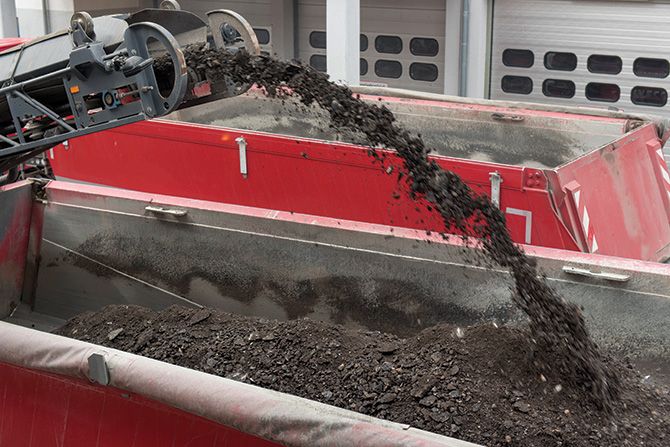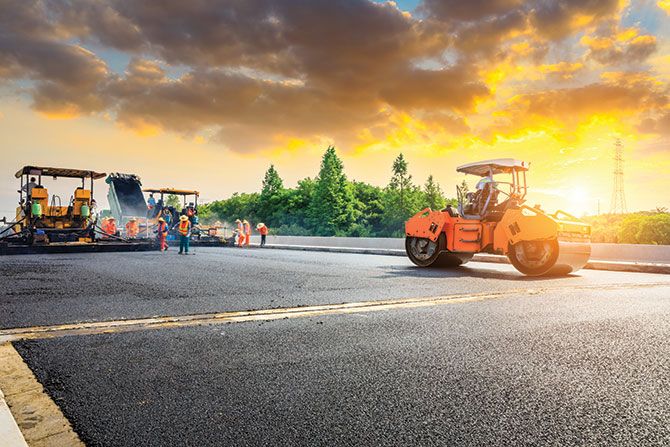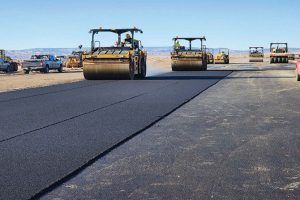America’s most recycled material is asphalt. Reclaimed asphalt pavement (RAP) is a valuable by-product, and there is a lot of it available for use. According to a 2019 survey by the National Asphalt Pavement Association (NAPA) in partnership with the Federal Highway Administration (FHWA), 97 million tons of RAP have been reclaimed by our industry for future use. Using RAP instead of new materials not only saves scarce natural resources like aggregates but is also environmentally friendly and cost-effective. Using RAP is considered green, which is a big incentive to recycle and
reuse asphalt.
Figures from the National Asphalt Pavement Association (NAPA) estimate that greenhouse gas emissions net reduction from the use of RAP in new asphalt mixtures from 2009 to 2019 was estimated at 21.2 million tons of CO2e. This is equivalent to the annual emissions from approximately 460,000 passenger vehicles. In 2019, more than 97 million tons of RAP were recycled in new asphalt pavements and other civil engineering applications, saving 58.9 million cubic yards of landfill space.
Annually, 89.2 million tons of RAP are used in new asphalt pavement construction throughout the United States. As a fully recyclable product, RAP has many applications, and can be used over and over again, reducing the need for costly virgin materials. More than 94% of RAP is used in new asphalt mixtures, while a small percentage is incorporated into other civil engineering applications like unbound aggregate bases. Nationally, RAP is utilized at an average rate of 21.1% in new asphalt mixtures.
Contractors and customers alike are always looking for ways to stay under budget without sacrificing quality. That’s where RAP comes in – it can help reduce waste and provide a cost-effective alternative to pricier materials. Each year, an average of $3.3 billion is saved by using RAP. Nationally, the average 21.1% RAP used in new asphalt mixtures saved $7.80 per ton, and that is impressive.
The use of RAP means less reclaimed asphalt is winding up in landfills. Additionally, as technology progresses, the percentage of asphalt that can be recycled increases and further reduces any negative environmental impact asphalt production might cause. Today, more projects are featuring increased amounts of RAP, meaning there’s less waste, lower costs, and higher
quality results.
Recycling is just one of the reasons that asphalt is considered one of the most sustainable pavements.
The industry is continuously exploring methods and practices to contribute to sustainable infrastructure and a healthy environment for future generations. Asphalt pavements that are constructed as Perpetual Pavements, that never need to be removed or replaced, do just that.
The concept of Perpetual Pavements has been around for 20+ years. These are asphalt pavements that are designed and built to last longer than 50 years without requiring major structural rehabilitation or reconstruction – needing only occasional surface renewal in response to distress on the top layer of pavement.

The construction of Perpetual Pavements does not differ from normal best practices. Planning is the key. It is important that attention be given to all stages of the production and placement of the material. The foundation should be strong and consistent to support traffic loads. The density and uniformity of asphalt mixtures are critical to the long-term health of the pavement. Careful attention must be given to the proper design of lift thicknesses, proper material selection and mix design, alongside appropriate construction practices. Additionally, bonding between pavement layers has also been shown to be essential to the long-term performance of the pavement structure. Quality control procedures are a must throughout the construction process.
The advantages of Perpetual Pavements include:
- Lower lifetime maintenance costs by avoiding deep pavement repairs or costly reconstruction
- Minimal user delay as the minor surface rehabilitation of asphalt pavements only requires a short work window that can avoid peak traffic hours
- Low environmental impact:
- Reducing the number of material resources over
the pavement’s lifetime - Recycling any materials removed from the
pavement surface
- Reducing the number of material resources over
The cost savings and increased life expectancy of Perpetual Pavement projects are endless, and we can’t afford to ignore that fact. Both high-volume highways and interstates and low-volume county roads and city streets can reap the benefits of Perpetual Pavement. Even if those structures were not originally designed or built to perpetual specifications, Perpetual Pavement can be achieved by increasing pavement thickness one inch of asphalt at a time – that extra inch of asphalt will pay for itself many times over by reducing long-term maintenance costs and doubling the life expectancy of the road itself.
Research continues at Perpetual Pavement test sites and facilities around the world. The data from these tests have shown that Perpetual Pavements are performing as well or better than expected. Long-life asphalt pavements have been shown time and time again to have lower life cycle costs than concrete pavements or conventionally designed pavements.
The Asphalt Pavement Alliance’s (APA) Perpetual Pavement Award program has nearly 70 examples of long-lasting asphalt pavements. The awarded projects shine a spotlight on the long-term performance of well-designed and well-constructed asphalt pavements. To learn more about these projects, you can visit the APA’s website at www.driveasphalt.org.
As you know, the asphalt industry plays a major role in keeping carbon emissions low, while simultaneously continuing to build a resilient transportation network that will move generations to come. In January of 2022, NAPA introduced The Road Forward program and its vision for zero net carbon emissions by 2050. Each of us can do our part to make this happen by paying attention to the products we use, the roads we build, and by working together to achieve our industry’s goal in the very near future.









